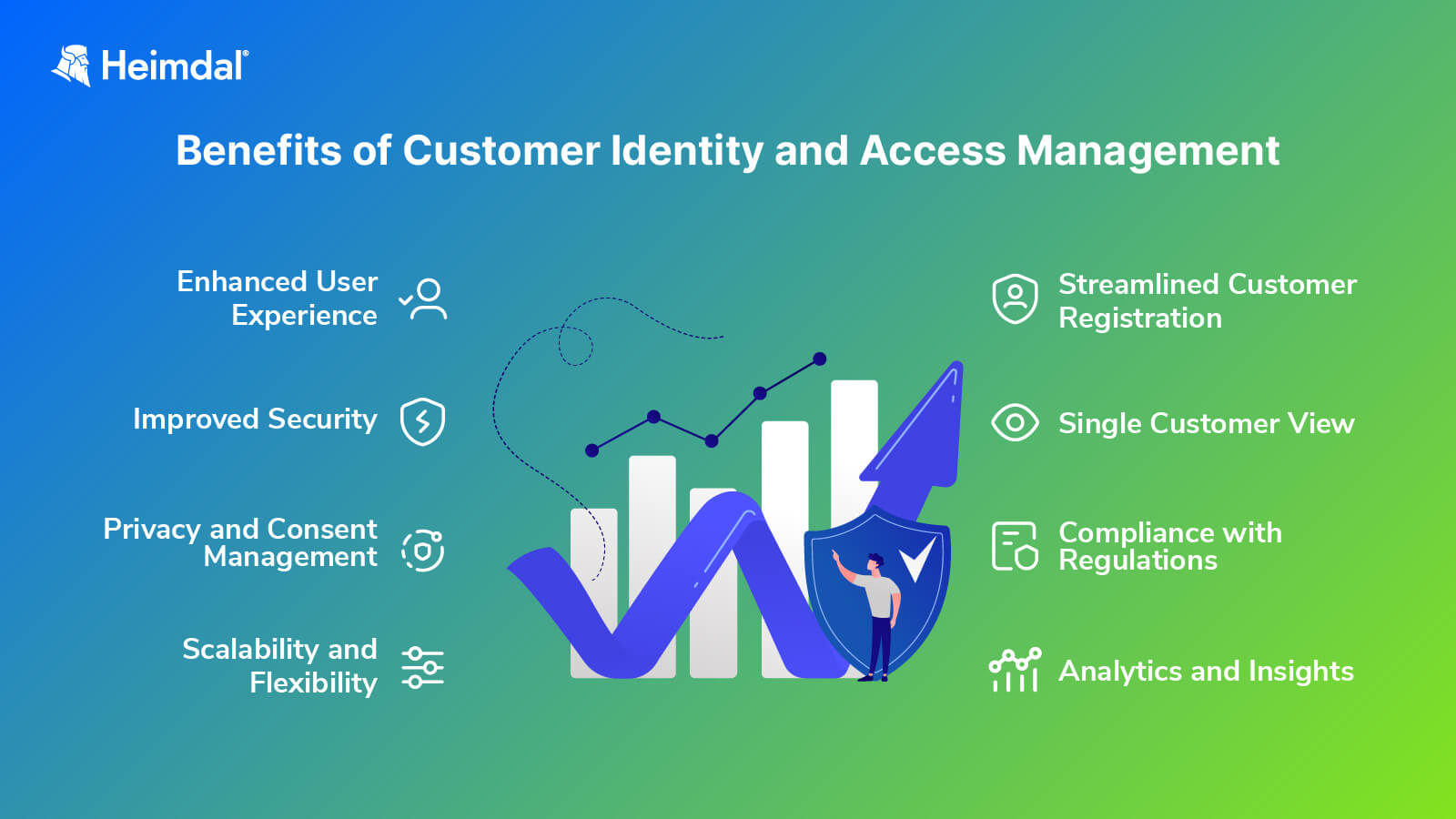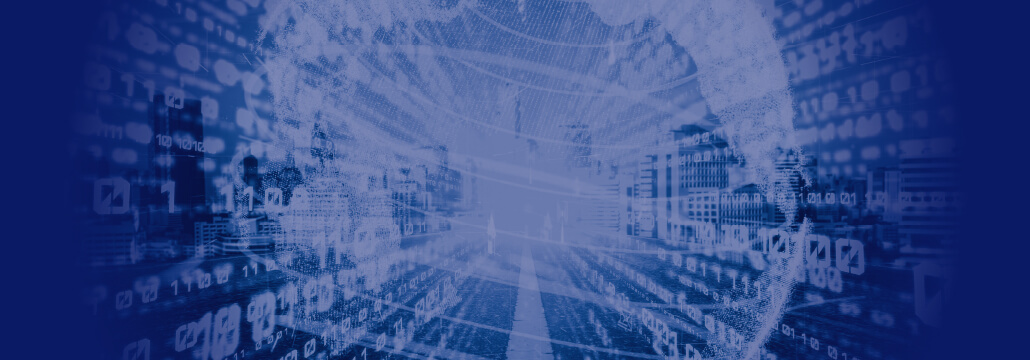Contents:
CIAM stands for Customer Identity and Access Management. It refers to a system or set of processes and tools created to manage and protect the online identities of external third parties (users or customers) across a business’s different platforms, apps, and services.
CIAM systems help companies handle customer registration, authentication, authorization, and profile administration efficiently while ensuring privacy, safety, and a smooth user experience.
Common features of Customer Identity and Access Management technologies include Single Sign-On (SSO), social login integration, access management, Multi-Factor Authentication (MFA), self-service account management, user activity tracking, identity orchestration, consent and preference management and, optionally, threat detection and fraud mitigation.
Thanks to these capabilities, organizations are able to provide customized and secure experiences for their clients, streamline access to many applications, collect relevant customer information for marketing and analytics purposes, and control access to public websites and digital properties.
CIAM systems make it simple for customers to sign up for and access services and apps while safeguarding data privacy and protecting against identity theft and other types of criminal activity.
These solutions can be offered via software installed on-premises, in private clouds, or Identity-as-a-Service (IDaaS) platforms (where services are hosted and managed by a trusted third party for maximum simplicity, speed, and scalability). No matter the delivery system, the objective is to make accessing apps, services, and platforms as easy and secure as possible.
CIAM Key Features
A Customer Identity and Access Management solution typically includes the following components:
Identity and Profile Management
This part focuses on capturing and managing the identities of customers, including their personal details, preferences, and demographic information. It entails creating and updating customer profiles, enabling users to manage their own information (self-service account management) while providing organizations with a comprehensive view of every customer.
Authentication and Authorization
This component deals with confirming users’ identities and permitting access to the right resources or services. It includes several authentication methods including username/password, social login, biometrics, and multi-factor authentication (MFA). Authorization determines the level of access privileges depending on customer roles (RBAC), permissions, or attributes (ABAC).
Multi-Factor Authentication
The majority of CIAM technologies include Multi-Factor Authentication (MFA) capabilities to protect against user impersonation and credential theft. With MFA, a user must provide multiple forms of proof to obtain access to a website or application, for instance, a password and a unique SMS code.
Single Sign-On (SSO)
SSO enables users to access various programs or services within a company’s ecosystem using only one set of login credentials. Users no longer have to remember multiple usernames and passwords, which increases convenience and enhances the overall user experience.
Consent and Preference Management
This component entails getting and controlling customer permission for data gathering, processing, and sharing. This way, customers can specify their communication preferences, like opting in or out of marketing communications, and it provides ways for users to exercise their information privacy rights.
Security and Privacy Controls
CIAM systems include strong security features to safeguard customer data and prevent unauthorized access. This includes encryption, secure communication protocols, threat detection, and monitoring techniques. Privacy controls ensure that data protection requirements are adhered to and that users have control over their own private data.
Integration and Federation
CIAM solutions integrate with an organization’s existing systems and applications, allowing for smooth access and data synchronization. Thanks to federation capabilities, customers are able to use their identities from trusted external sources, like social media accounts, to access services, having a more convenient user experience.
Analytics and Reporting
Analytics and reporting features are frequently included in CIAM solutions to gather data on customer behavior, engagement patterns, and demographics. The collected insights can be used to create targeted marketing campaigns, improve consumer experiences, and make data-driven business decisions.
Advanced Login Options
With Customer Identity and Access Management, a company can gain an advantage by using cutting-edge login options that are not yet generally employed. These login approaches further increase user experience, customers trust, or both. These options include:
- Passwordless Login,
- One-Touch Login, or
- Smart Login.
Benefits of Customer Identity and Access Management
CIAM (Customer Identity and Access Management) has numerous advantages for both enterprises and customers. Here are some of the main benefits of such a solution:

Enhanced User Experience
CIAM tools offer a seamless and customized user experience by enabling users to access many apps and services with a single set of credentials. This eliminates friction and boosts customer satisfaction, resulting in increased engagement and loyalty.
Improved Security
CIAM technologies use strong authentication methods such as multi-factor authentication (MFA), encryption, and secure communication protocols in order to ensure safe access to user accounts. This improves overall security by lowering the risk of fraud, identity theft, and unauthorized access.
Privacy and Consent Management
Customer Identity and Access Management platforms give users control over their private information and consent to data collection and processing. They are able to manage their preferences, decide which personal details to disclose, and enforce their right to data confidentiality. This fosters trust and demonstrates compliance with privacy guidelines, boosting confidence among customers.
Scalability and Flexibility
Security tools such as CIAM are developed to handle high volumes of customer identities and user traffic. They are scalable to handle expanding user bases and adaptable to various programs and services. This adaptability enables companies to broaden their online services without impacting performance.
Streamlined Customer Registration
CIAM services make the client registration procedure easier by providing multiple registration options, which include social login integration, reducing friction and eliminating the need for users to create new credentials. This results in higher conversion rates and more rapid onboarding.
Single Customer View
A CIAM approach gives businesses a consolidated picture of their customers’ information and profiles, helping them to understand better their preferences, behaviors, and demographics. As mentioned earlier in this article, thanks to this comprehensive view, marketing teams can better target their audiences, offer personalized experiences, and improve customer segmentation.
Compliance with Regulations
CIAM helps businesses in complying with data protection laws, such as the General Data Protection Regulation (GDPR) and California Consumer Privacy Act (CCPA). They streamline the adoption of privacy controls, consent management, and data processing practices, reducing legal and reputational concerns.
How Do CIAM and IAM Differ?
The concepts of CIAM (Customer Identity and Access Management) and IAM (Identity and Access Management) are similar, but their focus and scope differ. Here are the fundamental differences between CIAM and IAM:
Target Audience
The main focus of CIAM is managing and securing customer identities and access within customer-facing apps and services. On the other hand, IAM is all about managing identities and access for workers, vendors, collaborators, and other internal stakeholders within a company’s IT environment.
Level of Security
In most cases, IAM faces significantly fewer challenges when it comes to securing the details of those to whom it allows access. For instance, if a staff member has to log in to a particular area of the organization’s network, an IAM solution may only need to provide a framework for the requirement of a username, password, and a biometric feature, like a fingerprint. After logging in, the user has access to the resources they need, but they do not have to store much of their private data in the system.
The risks increase when providing customers access. They frequently have confidential personal data or financial information that has to be stored in systems. This could include Social Security numbers, medical records, and credit card details. Consequently, more rigorous security measures might need to be implemented for CIAM systems.
Use Cases
CIAM is extensively employed in sectors where clients use many different websites and services, like e-commerce, finance, medical services, etc. Alternatively, IAM is used to handle internal user access to the company’s assets, systems, and apps, making sure the relevant people have appropriate access based on their positions and tasks.
User Experience
With features like single sign-on (SSO), social login integration, and self-service profile management, CIAM focuses on providing a frictionless and customized user experience for customers. While IAM may provide some user self-service capabilities, its focus is on implementing security policies and ensuring compliance rather than offering a consumer-like experience.
Scale and Complexity
Scalability is a key distinction between CIAM and IAM. CIAM has to scale to manage millions of users, often during significant surges in traffic, such as on peak shopping days, as opposed to solutions like IAM, which support thousands of entities that need relatively limited access to a pre-assigned list of apps.
What Does Heimdal® Bring into the Whole Identity and Access Security Landscape?
When it comes to IAM, we recommend integrating Privileged Access Management within your strategy.
Due to the evolution and growth of the “work from home” approach, more and more users are granted privileges because they need different accesses to perform their jobs, so these privileges are no longer limited solely to IT administrators, as anybody can now become a privileged user. That’s why the necessity to integrate an efficient Privileged Access Management approach into an Identity and Access Management Strategy has become more and more self-understood.
Since privileged accounts have special permissions and are the ones close to the most critical data of an organization, they, of course, require special attention and management that only can be acquired through a powerful PAM strategy powered by an automated Privileged Access Management Solution that will properly manage the approval/denial flow to privileged sessions.
A PAM solution will enforce the principle of the least privilege and here’s the benefit of it being integrated with IAM: this ensures that only the appropriate users, who can prove their identities via IAM, have access to the right systems, which are managed by PAM solutions.

Heimdal® Privileged Access Management
- Automate the elevation of admin rights on request;
- Approve or reject escalations with one click;
- Provide a full audit trail into user behavior;
- Automatically de-escalate on infection;
Heimdal’s Privileged Access Management solution is remarkable due to its characteristics:
- When used together with our Nex-Gen Antivirus, it turns into the only software that automatically de-escalates user rights, in case there are threats are detected on the machine.
- Lightweight and stunning interface giving you complete control over the user’s elevated session. Approve or deny from the dashboard or on the go right from your mobile device.
- You have the Zero – Trust Execution Protection display in the Privileges & App Control – Privileged Access Management view, that includes many details like the processes (non-signed executable files) that the zero-trust execution protection engine intercepted, with data on Hostname, Username, Process Name, MD5 Hash, Timestamp, andStatus.
- Advanced data analytics that will help investigate incidents and perform regular security checkups. Obtain graphic-rich reports on hostname details, average escalation duration, users or files escalated, files or processes ran during escalation, and more.
Further, you can add our Application Control module into the mix, and you will be able to perform application execution approval or denial or live session customization to further ensure business safety.
If you enjoyed this article, follow us on LinkedIn, Twitter, Facebook, or YouTube to keep up to date with everything we post!


 Network Security
Network Security
 Vulnerability Management
Vulnerability Management
 Privileged Access Management
Privileged Access Management
 Endpoint Security
Endpoint Security
 Threat Hunting
Threat Hunting
 Unified Endpoint Management
Unified Endpoint Management
 Email & Collaboration Security
Email & Collaboration Security










